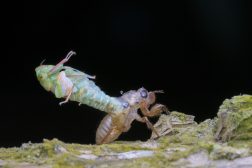Definition
noun, plural: tapeworms
Any of the ribbon-like parasitic worms of the class Cestoda, characterized by possessing a scolex (head) with bothria that aid in attaching to their host, as well as a thin, long strobila body resembling a strip of tape or ribbon
Supplement
The phylum Platyhelminthes (flatworms) is comprised of parasitic worms characterized mainly by their flattened, bilaterally symmetrical body. This phylum includes the four classes: (1) Turbellaria, (2) Trematoda, (3) Monogenea, and (4) Cestoda.
The class Cestoda is comprised of parasitic worms in which the body resembles a ribbon or tape (thus, the name tapeworm). Typically, their life cycle involves two types of animal hosts: a definitive host (e.g. humans and primates) and an intermediate host (i.e. another vertebrate host, such as cattle, pig, etc.). The adult tapeworms inhabit the intestinal tract of the definitive host whereas the juvenile tapeworms infect the tissues, such as muscles, of the intermediate host. The head of the tapeworm is referred to as scolex. The scolex has sucking grooves called bothria. The worm uses the bothria as suction cups to attach to the gut of the host. The body of the tapeworm is a strobila that is comprised of proglottids. The strobila is thin and resembling a strip of tape, thus, the name (tapeworm). The proglottids located distally contain the eggs, which are the infective phase of the worm.
Examples of tapeworm species are Taenia solium (pork tapeworm), Taenia saginata (beef tapeworm), Diphyllobothrium spp. (fish tapeworm), etc. Most tapeworm infections occur in Africa, Yugoslavia, the Middle East, Southeast Asia, Mexico and parts of south America and the U.S.S.R. Some forms may be contracted (in the U.S.) from infected dogs or cats (more common in children) by ingestion of infected fleas. Taenia solium (pork tapeworm) is occasionally encountered in the united states today in immigrants or visitors from endemic areas. Taenia saginata (beef tapeworm) is seen more often, especially in those who consume raw beef. Some tapeworms have been known to live up to 20 years and exceed 10 metres in length. Often asymptomatic infestations, but unexplained weight loss, symptoms of pernicious anaemia and the presence of white eggs or ribbon-like segments of worm in stools can be seen in some.
Scientific classification:
- Kingdom: Animalia
- Phylum: Platyhelminthes
- Class: Cestoda
See also:







